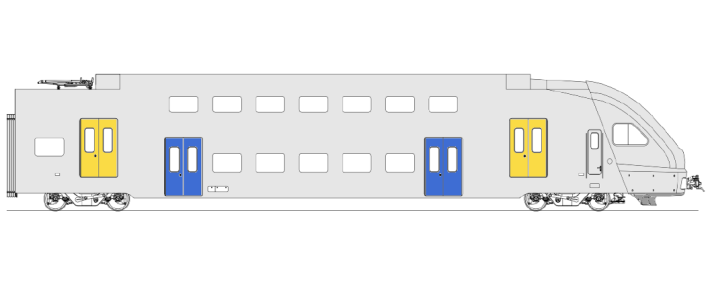
The insistence of California High Speed Rail officials on running trains with floors 50 inches above the tracks threatens to reduce the capacity of Caltrain and hamper the benefits of level boarding for the commuter rail agency.
Last Tuesday, Caltrain officials gave an update on the electric trains the agency plans to purchase next year, which will begin operating in 2021 [PDF]. To enable level boarding for Caltrain passengers before and after CAHSR raises platforms to be compatible with its 50-inch floor trains, the new design has two sets of doors at different heights. This way, both Caltrain and high-speed trains will have level boarding at every station.
High Speed Rail Authority officials insist on the high-speed train industry standard floor height of 50 inches above the tracks. Building trains compatible with this specification, however, will diminish both the speed of Caltrain service and its capacity, though the scale of these effects has yet to be determined.
In order to achieve level boarding fully compatible with High Speed Rail, Caltrain will need to allow passengers to board at the 50-inch height. But a lower 25-inch floor height above the tracks is needed for the main section of each car in order for the trains to have both a lower and upper level, like today's newer Bombardier models, without being too tall to operate.
This will require passengers to navigate sets of internal stairs on the lower level. This will increase the length of time people spend boarding and alighting, especially people carrying bicycles or luggage. Mechanical lifts will also be needed for passengers in wheelchairs to get between the 25-inch and 50-inch levels. The overall effect will be to lengthen the amount of time trains spend at each station (the "dwell time") compared to trains with a single lower-level floor height.
That delay hasn't yet been estimated by either agency, but it will affect Caltrain's schedules. "The reason to go to level boarding for Caltrain is dwell time," said Friends of Caltrain Director Adina Levin. "So the question of how much the internal stairs extend dwell time is a very important question about the benefits of level boarding."
In addition, two sets of doors at both floor heights will be needed, which will consume valuable space that could have been devoted to seats or bicycles. An estimated 78 to 188 seats will be lost per six-car train. Agency officials have clarified that this need not occur until the High Speed Rail stations are actually built, because trains could be built without the upper set of doors, initially, in order to temporarily preserve space for seating.
"The key part of the rail car is where people in wheelchairs and bicyclists are going to be sitting in," said Bay Rail Alliance Board President Andy Chow. "In any of the high platform scenarios, there isn't enough space in the high floor portions [of the train] to have seating for wheelchair users and bicyclists."
To avoid these drawbacks, high-speed trains with a lower floor height than 50 inches would be needed, such as the Talgo AVRIL under development in Europe. But so far, High Speed Rail officials haven't been willing to consider such "low-floor" high-speed trains, choosing the industry standard 50-inch height despite the operational drawbacks for Caltrain.
"Ridership growth trends are expected to continue, and both Caltrain and all the transit services that connect to it will need to maximize opportunities that boost passenger capacity to keep up," said Levin. "Caltrain and High Speed Rail should bring in global experts who work on blended systems to give them advice including relating to High Speed Rail's concerns about the viability of low-floor high-speed trains."
The issue is expected be discussed tomorrow by both the agency's Board of Directors and Citizen's Advisory Committee, as well as how much space to allocate for seats, bicycles, and bathrooms aboard Caltrain's future electric trains.




